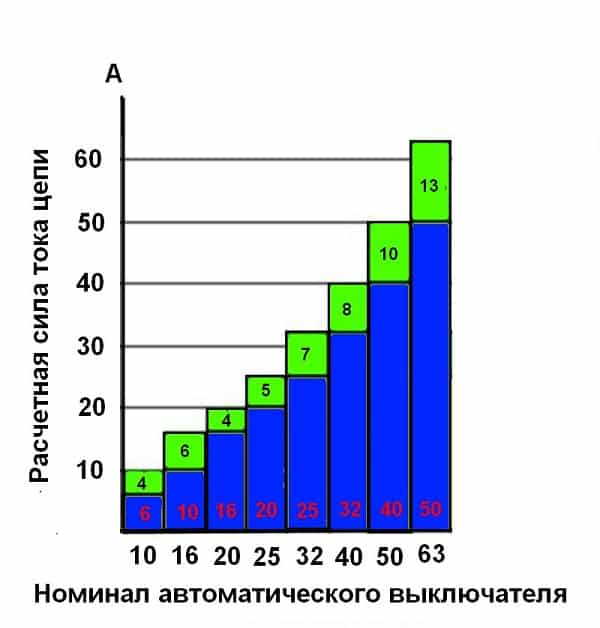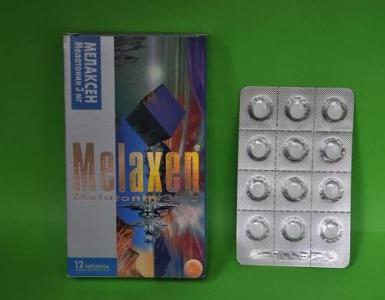Tripping of the circuit breaker. Features of single-pole automata. Characteristics of operation of protective circuit breakers
Hello, dear readers of the site.
In this article we will consider the main characteristics automatic switches, which you need to know in order to navigate correctly when choosing them - this is rated current and time current characteristics of circuit breakers.
I would like to remind you that this publication is included in a series of articles and videos devoted to electrical protection devices from the course
The main characteristics of the circuit breaker are indicated on its housing, where the trademark or manufacturer's brand and catalog number or serial number are also affixed.
The most important characteristic of the circuit breaker - rated current. This is the maximum current (in Amps), which can flow through the machine indefinitely without disconnecting the protected circuit. If the current exceeds this value, the machine will fire and open the protected circuit.
A number of values of the rated current of circuit breakers is standardized and is:
6, 10, 16, 20, 25, 32, 40, 50, 63, 80, 100A.
The value of the rated current of the machine is indicated on its case in amps and corresponds to an ambient temperature of + 30 ° C. With increasing temperature, the value of the rated current decreases.
At the time of connection in electrical network Some consumers, for example, refrigerators, vacuum cleaners, compressors, etc. in the circuit, short-time starting currents, which can several times exceed the rated current of the machine. For the cable, such short-term current spikes are not terrible.
Therefore, to ensure that the machine does not turn off every time with a slight short-term increase in the current in the circuit, automatic machines with different types of time-current characteristics are used.
Thus, the following main characteristic:
time-current response characteristic of the circuit breaker - this is the dependence of the disconnection time of the protected circuit, on the strength of the current flowing through it. The current is indicated as a ratio to the rated current I / I, i.e. the number of times the current flowing through the circuit breaker exceeds the rated current for the given circuit breaker.
The importance of this characteristic lies in the fact that automata with the same will be switched off in different ways (depending on the type of time-current characteristic). This makes it possible to reduce the number of false positives by applying circuit breakers with different current characteristics for different types of load,
Consider the types of time-current characteristics:
— Type A (2-3 rated current values) are used to protect circuits with a large extension of the electrical wiring and to protect semiconductor devices.
— Type B (3-5 rated current values) are used to protect circuits with a low starting current multiplicity with a predominantly active load (incandescent lamps, heaters, furnaces, general lighting mains). Indicated for use in apartments and residential buildings, where the loads are mostly active.
— Type C (5-10 rated current values) are used to protect the circuits of installations with moderate starting currents - air conditioners, refrigerators, home and office outlet groups, gas discharge lamps with increased starting current.
— Type D (10-20 rated current values) are used to protect circuits supplying electrical installations with high starting currents (compressors, lifting mechanisms, pumps, machine tools). They are installed mainly in production premises.
— Type K (8-12 rated current values) are used to protect circuits with inductive loads.
— Type Z (2,5-3,5 rated current values) are used to protect the circuits with electronic devices sensitive to overcurrents.
When choosing a circuit breaker to protect electrical equipment, many take into account the rated current, voltage and number of poles (single-pole, two-pole, three-pole or four-pole) switches. Which is basically true, but there is one "but".
In practice, there are cases when picking up an automatic switch for protecting an asynchronous electric motor, according to the nominal data of the machine, and installing it, upon start-up, the switch trips and breaks the circuit. What is the reason? After all, everything is chosen correctly, the currents are the same, the voltage too, with the number of poles is very difficult to guess, but the machine is triggered when starting.
The point is that when the induction motor is started directly, the stator current reaches about seven rated currents. Therefore the machine works? Yes, that's why. But picking up another, the same machine, but with a different response characteristic, this system works fine.
Therefore, when selecting circuit breakers, you should pay attention to its response characteristics and compare them with the schedule of your load. Let's look at the basic characteristics of circuit breakers.
Characteristic of MA
This type of circuit-breaker does not have a thermal release and is only suitable for short-circuit protection. Most often it is used in protection circuits of electric drives where the overload protection is implemented in another way (current relays, microprocessor systems).
Characteristic A
Designed to protect the circuits in which there is no overcurrent. It can be semiconductor devices failing when the set current values are exceeded. The graph of this characteristic is shown below:
As we see from the graph with an overload of 1.13 -1.45 I n, the thermal release can work for 60 minutes, and at 2-3 times the overshoot - almost instantaneously.
Characteristic B
This type of protection is often used for computer and electronic equipment or in systems where the starting peaks are small, and the system is subject to very low overloads. The graph is shown below:
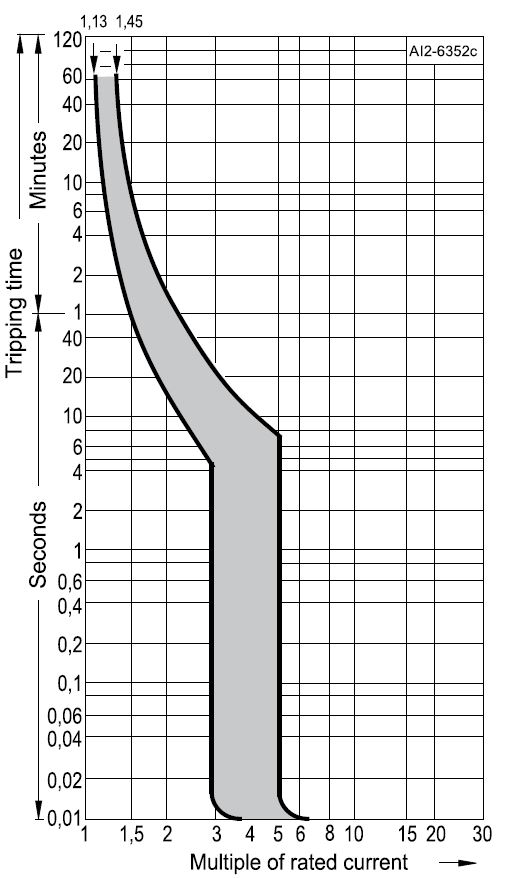
With long modes it does not differ from the characteristic A, but at start-up it can withstand a larger current of 3 - 5 ratings.
Characteristic C
The most common characteristic of circuit breakers. It is used practically in all power supply systems with moderate starting currents, therefore practically in any switchboard it is possible to see this device. The graph below:
![]()
As you can see, their overload capacity lies in the range of 5 to 10 denominations. That allows them for a short time to pass moderate values of the starting current.
Characteristic D
Applicable for the protection of motors that are started directly from the network without the use of converters, and having large jumps in inrush currents, as well as for other devices having large short-time overloads. The graph below:

In these devices, short-time overloads can reach 10 - 20 ratings.
Characteristic K
This type of machine has a fairly large range of spreading of the operating current when operating at a constant and alternating voltage and use it, as a rule, in circuits with inductive load, sometimes for electric motors and various power converters. The trigger curve is shown below:
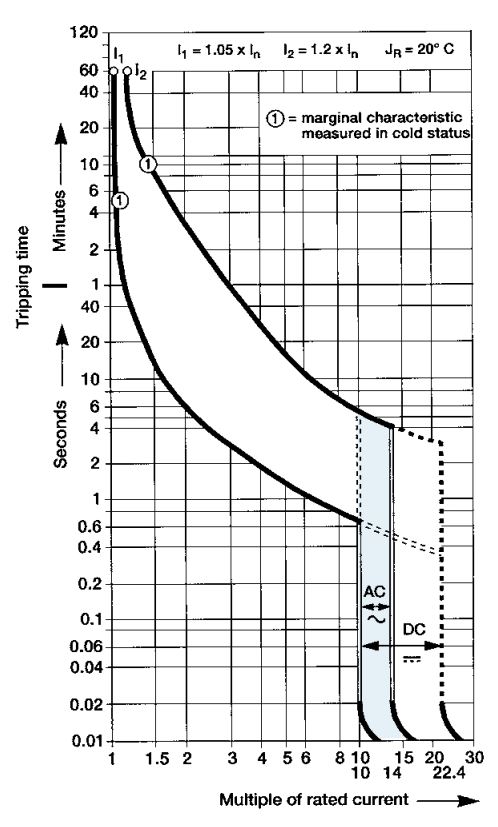
As we see in the "change" the switch-off range is 10 - 15 ratings, with "constant" 10 - 25 ratings.
Characteristic Z
It also has a spread when operating at AC and AC voltage and is designed to provide maximum protection for electronic control devices. The work curve is shown below:
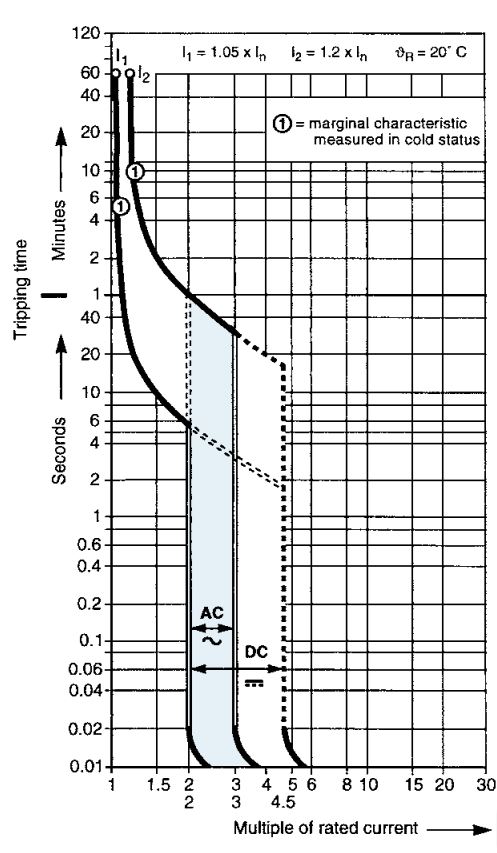
When working at alternating voltage, the trip occurs when reaching 2 - 3 ratings, with a constant 2 - 5.
As you can see, the choice of a circuit breaker for protection electrical circuits It's not such a simple task as it seems at first glance. Therefore, when choosing a circuit breaker, you need to compare not only the nominal data (voltage, current, phase), but also to know the characteristics of the system for which the automatic device is selected, so that the circuit breaker you selected fully protects your equipment.
The time-current characteristic curve D of the circuit-breaker differs from B and C in that the rapid disconnection of the load current occurs in the range from 10 to 14 times the rated current of the circuit-breaker.
The specificity of the time-current characteristic D is that the automata of characteristic D are used mainly in industry, for the protection of electric motors and their supply lines. Since when starting the electric motor, it does not go directly to the rated mode, but accelerates for a while, then the starting currents during the acceleration of the motor are much higher than the current consumed by the dive in normal, operating mode and can reach ten times the operating current, the C more B can not be used for such purposes, since this will lead to the impossibility of starting the electric motor in connection with the cut by the next start-up of the circuit breaker after exceeding the current.
The D-Rating machine with a rating of 40 Amperes will not turn off when the motor starts, even if the inrush current reaches 400 amperes for less than 1 second, it can also not turn off at higher currents, in the case of an even shorter period of inrush current.
Characteristic D of the thermal trip of the circuit breaker
The time-current characteristic curve D shows clearly that the thermal release, whose operating speed refers to a time greater than 15 milliseconds, allows non-breaking starting current of up to three ratings for five seconds, five ratings for two seconds and ten ratings for one second . Considering that at start-up, the most powerful starting current is formed at the moment of power-up, and further, as the rotor of the engine is untwisted, tending to the rated current of the electric motor, then in the case of non-switching of the automaton at the first moment, which will speak of incorrect choice of the nominal value of the machine, then the further process of starting the electric motor will be normal and the circuit breaker will not shut down by starting current.Characteristic D of the electromagnetic trip of the circuit breaker
The electromagnetic release, whose operation is described by the lower part of the time-current characteristic curve D, is characterized by a high, millisecond, operating speed at high currents flowing through the coil of the release.The device and characteristics of the electromagnetic release time of the current characteristic D practically do not differ from the characteristics of the release for curves B and C, since in all versions of circuit breakers, the electromagnetic release serves to prevent a short circuit and is not tied to the current rating of the machine.
Circuit breakers are called devices that are responsible for protecting the electrical circuit from damage associated with the influence of a large current on it. Too much flow of electrons can disable household appliances, as well as cause overheating of the cable, followed by reflow and ignition of insulation. If the line is not de-energized in time, it can lead to a fire. Therefore, in accordance with the requirements of the Electrical Installation Rules, the operation of a network in which there is no electric machines protection, is prohibited. AB have several parameters, one of which is the current characteristic of the automatic safety switch. In this article, we will describe how circuit breakers of categories A, B, C, D differ and to protect which networks they are used for.
Features of the network protection automata
Whichever class the circuit breaker belongs to, its main task is always one - to quickly determine the occurrence of excessive current, and to de-energize the network before it damaged cable and connected to the device line.
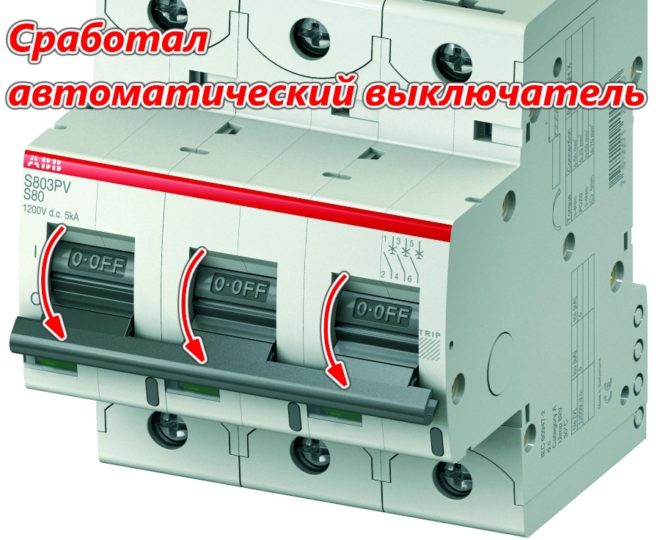
The currents that can pose a danger to the network are divided into two types:
- Overload currents. Their appearance is most often due to the inclusion of devices in the network, the total power of which exceeds what the line can withstand. Another cause of overloading is the malfunction of one or more devices.
- Overcurrents caused by short circuit. A short-circuit occurs when the phase conductor and the neutral conductor are connected together. In the normal state, they are connected to the load separately.
The device and principle of operation of the circuit breaker - on video:
Overload currents
Their value is often slightly higher than the value of the machine, so the passage of such an electric current through the circuit, if it does not take too long, does not cause damage to the line. In this connection, instantaneous de-energizing is not required in this case, besides, the amount of the electron flux often quite quickly returns to normal. Each AB is designed for a certain excess of the electric current, at which it operates.
The operating time of the protective circuit-breaker depends on the amount of overload: with a slight excess of the norm, it can take an hour or more, and if significant - a few seconds.
For a power failure under the influence of a powerful load, a thermal release is based on a bimetallic plate.
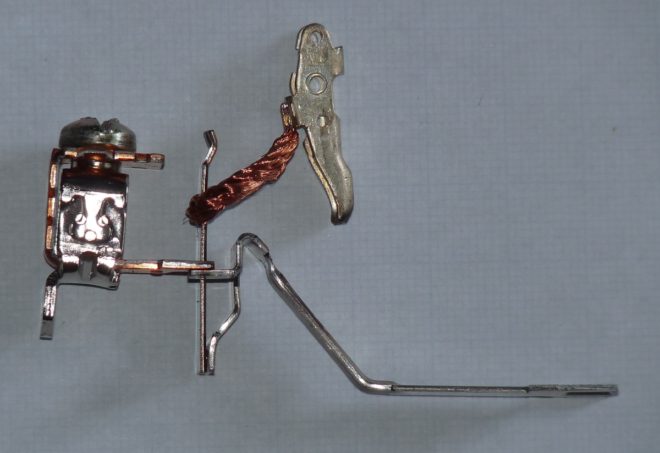
This element heats up under the influence of a powerful current, becomes plastic, bends and triggers the automatic device.
Short circuit currents
The flow of electrons caused by short-circuiting is much higher than the rating of the protection device, as a result of which the latter immediately works by switching off the power. For the detection of short-circuiting and an immediate reaction of the device, an electromagnetic release is described, which is a solenoid with a core. The latter, under the influence of overcurrent, instantly acts on the switch, causing its actuation. This process takes a split second.
However, there is one nuance. Sometimes the overload current can also be very large, but not caused by a short circuit. How should the apparatus determine the difference between them?
On the video about the selectivity of circuit breakers:
Here we smoothly turn to the main question, to which our material is devoted. There are, as we have already said, several classes of AB, differing in time-current characteristics. The most common ones that are used in household electrical systems are devices of classes B, C and D. Circuit breakers belonging to category A are much less common. They are the most sensitive and are used to protect high-precision devices.
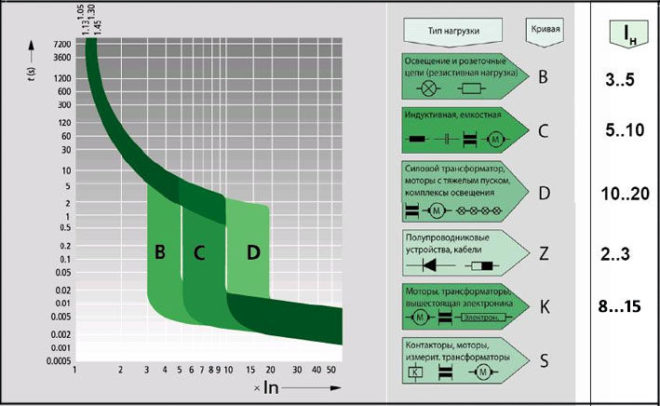
Between each other these devices differ in the instantaneous tripping current. Its value is determined by the multiplicity of the current passing through the circuit to the nominal value of the machine.
Characteristics of operation of protective circuit breakers
Class AB, determined by this parameter, is denoted by the Latin letter and placed on the body of the machine in front of the figure corresponding to the rated current.
In accordance with the classification established by the SAE, the safety devices are divided into several categories.
MA type automatons
A distinctive feature of such devices is the absence of a thermal release in them. Apparatuses of this class are installed in circuits connecting electric motors and other powerful aggregates.
Overload protection in such lines is provided by the overcurrent relay, the circuit breaker only protects the network from damage caused by the action of overcurrent short circuits.
Class A instruments
Automata type A, as was said, have the highest sensitivity. Thermal release in devices with a time characteristic A most often works when the current exceeds the rated AB by 30%.

The electromagnetic decoupling coil de-energizes the network for approximately 0.05 seconds if the circuit current exceeds the rated current by 100%. If, for any reason, after an increase in the electron flux by half the electromagnetic solenoid did not work, the bimetal release releases the power within 20 to 30 seconds.
Automatic machines having a time characteristic A are included in the lines, during which even short-time overloads are inadmissible. These include chains with semiconductor elements included in them.
Safety devices of class B
Apparatuses of category B have less sensitivity than type A. The electromagnetic release in them is triggered when the rated current is exceeded by 200%, and the pickup time is 0.015 sec. The operation of the bimetallic plate in the circuit breaker with characteristic B at a similar excess of the nominal value AB takes 4-5 seconds.
The equipment of this type is intended for installation in lines in which sockets, lighting devices and in other circuits are included, where the starting increase in the electric current is absent or has a minimum value.

Automatic devices of category C
Devices of type C are most common in household networks. Their overload capacity is even higher than that of the previously described ones. In order for the solenoid of electromagnetic disconnection set in such a device to operate, it is necessary for the electron flux passing through it to exceed the nominal value by 5 times. Tripping of the thermal release at a fivefold excess of the protection device rating takes place after 1.5 seconds.
Installation of circuit breakers with a time characteristic C, as we said, is usually done in household networks. They do an excellent job of introducing input devices to protect the public network, while for individual branches, to which groups of outlets and lighting devices are connected, the category B.
This will allow to observe the selectivity of protective devices (selectivity), and in case of short circuit in one of the branches there will not be a de-energization of the whole house.
Automatic switches of category D
These devices have the highest overload capacity. To trigger an electromagnetic coil installed in this type of apparatus, it is necessary that the rating of the protective circuit is exceeded by a factor of at least 10 times.

The tripping of the thermal release occurs in this case after 0.4 sec.
Devices with characteristic D are most often used in general networks of buildings and structures, where they play a safety role. Their operation occurs in the event that there has not been a timely power failure by circuit-breakers in separate rooms. They are also installed in circuits with a large amount of starting currents, to which, for example, electric motors are connected.
Protective devices of category K and Z
The automata of these types are much less common than those described above. Devices of type K have a wide spread in the current values necessary for electromagnetic disengagement. So, for the chain alternating current this indicator should exceed the nominal value by 12 times, and for the constant one - at 18. The electromagnetic solenoid is activated in no more than 0.02 seconds. The tripping of a thermal release in such equipment can occur when the rated current is exceeded by only 5%.
These features are due to the use of devices of type K in circuits with an exclusively inductive load.
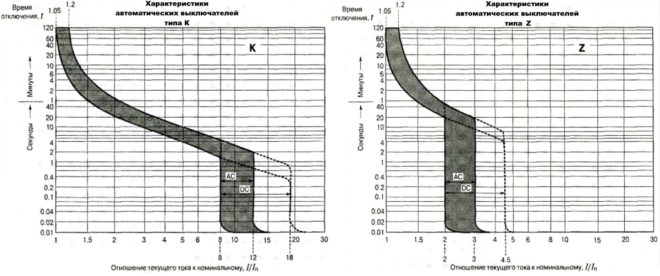
Instruments of type Z also have different actuation currents of the solenoid of electromagnetic disengagement, but the spread is not so great as in AB of category K. In alternating current circuits for their disconnection, the excess of the current rating should be threefold, and in networks of constant - the value of the electric current must be in 4.5 times the nominal.
Devices with the characteristic Z are used only in the lines to which electronic devices are connected.
Conclusion
In this article, we examined the current characteristics of protective devices, the classification of these devices in accordance with the EAE, as well as figured out which circuits are installed devices of different categories. The information obtained will help you determine which protective equipment should be used on the network, based on what devices are connected to it.
In practical applications, it is important not only to know the characteristics of circuit breakers, but also to understand what they mean. Thanks to this approach, you can decide on most technical issues. Let's consider what is meant by one or other of the parameters indicated on the marking.
Used abbreviation.
The marking of devices contains all the necessary information describing the main characteristics of circuit breakers (hereinafter AB). What they mean, will be described below.
With this graphic display, you can get a visual representation of the conditions under which the circuit breaker will be activated (see Figure 2). On the graph, the time required to activate AB is displayed as the vertical scale. The horizontal scale shows the I / In ratio.
Fig. 2. Graphical display of the current characteristics of the most common types of automata
Permissible excess of the nominal current, determines the type of time-current characteristics for releases in devices that produce automatic shutdown. In accordance with the current standard (GOST P 50345-99), each type is assigned a certain designation (from Latin letters). The permissible excess is determined by the coefficient k = I / In, for each type the values set by the standard are provided (see Fig.3):
- "A" - maximum - threefold excess;
- "B" - from 3 to 5;
- "C" - 5-10 times more than full-time;
- "D" - 10-20 times the excess;
- "K" - from 8 to 14;
- "Z" - in 2-4 more than full-time.

Figure 3. Basic activation parameters for different types
Note that this graph completely describes the conditions for the activation of the solenoid and the thermoelement (see Fig. 4).
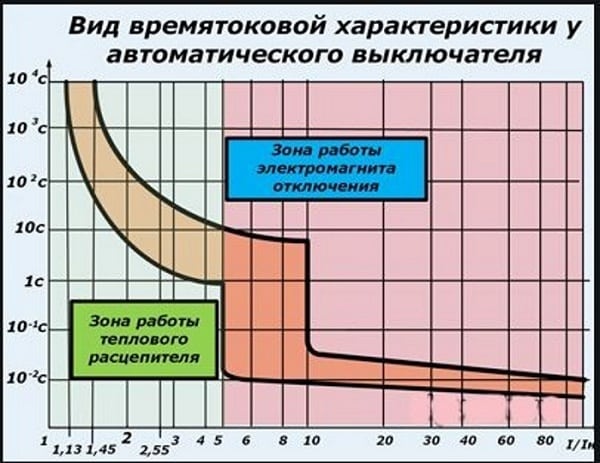
Considering all the above, it can be summarized that the main protective characteristic of AB is due to time-current dependence.
List of typical time-current characteristics.
Having defined the marking, we will pass to the consideration of various types of instruments that correspond to a certain class, depending on the characteristics.
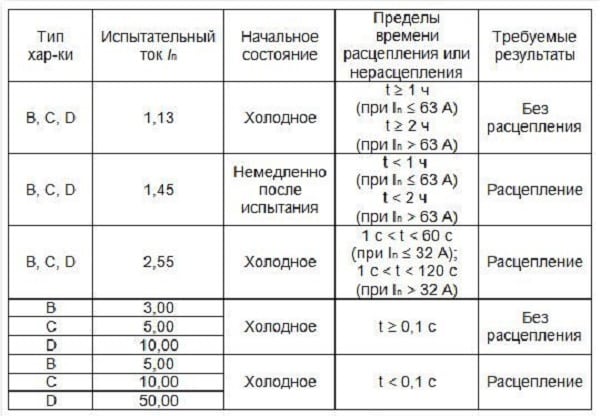
Characteristic type "A"
Thermal protection of this category AB is activated when the ratio of the circuit current to the rated current (I / I n) exceeds 1.3. Under such conditions, the shutdown will occur after 60 minutes. As the nominal current is further exceeded, the tripping time is shortened. Activation of electromagnetic protection occurs at twice the nominal value, the response rate is 0.05 seconds.
This type is installed in circuits not subject to short-time overloads. As an example, we can cite schemes on semiconductor elements, in the event of failure of which, the current is insignificant. In everyday life this type is not used.
Characteristic "B"
The difference of this type from the previous one is in the operating current, it can exceed the nominal three to five times. In this case, the mechanism of the solenoid is guaranteed to be activated with a five-fold load (the dead time is 0.015 seconds), the thermocouple is triple (it takes no more than 4-5 seconds to trip).
Such types of devices have found application in networks for which high starting currents, for example, lighting circuits are not characteristic.
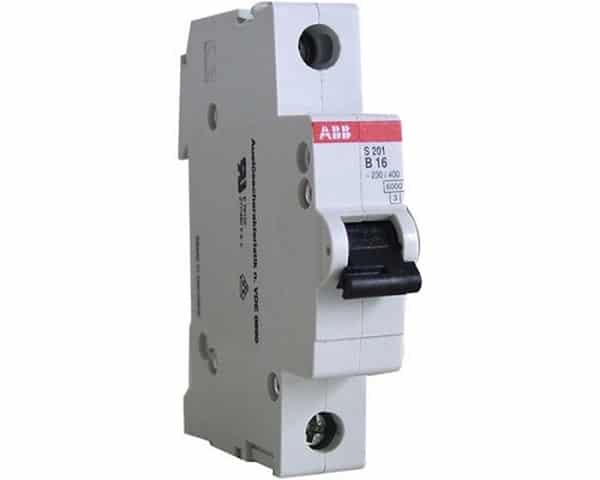
Characteristic "C"
This is the most common type, its permissible overload is higher than that of the two previous species. With a fivefold excess of the nominal mode, a thermocouple is triggered, this is a circuit that disconnects the power supply for one and a half seconds. The mechanism of the solenoid is activated when the overload exceeds the norm by a factor of ten.
The data AB are designed to protect the electric circuit, in which there may be a moderate inrush current, which is typical for a household network, which is characterized by a mixed load. Buying a device for the house, it is recommended to stop your choice on this form.
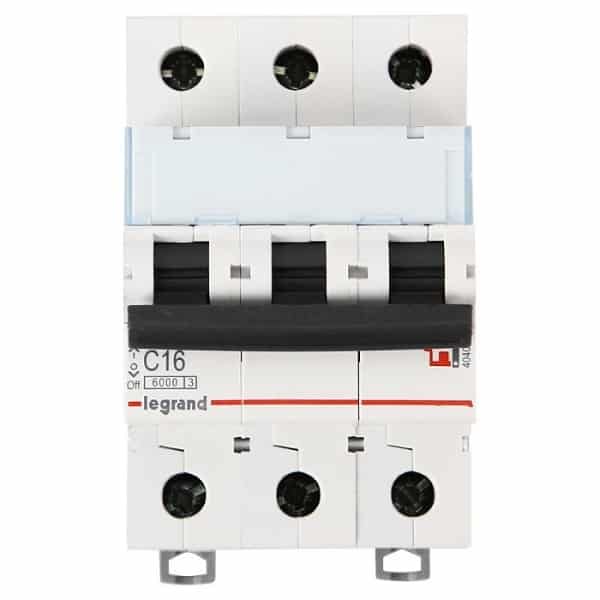
Three-pole automatic machine Legrand
Characteristic "D"
For AB of this type, high overload characteristics are characteristic. Namely, a tenfold excess of the standard for a thermocouple and twenty times for a solenoid.
Such devices are used in circuits with large starting currents. For example, to protect the starting devices of induction motors. Figure 9 shows two devices of this group (a and b).
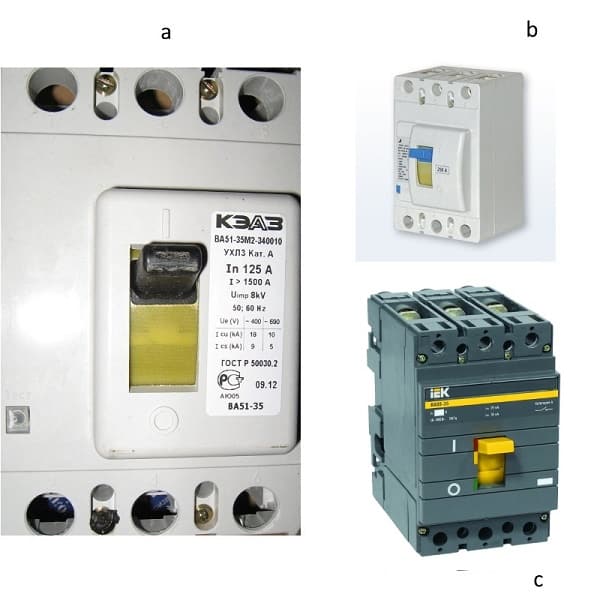
Figure 9. a) BA51-35; (b) BA57-35; c) BA88-35
Characteristic "K"
In such AV, the activation of the solenoid mechanism is possible when the current load is exceeded by a factor of 8, and it is guaranteed to happen when there is a twelve-fold overload of the nominal mode (eighteen times for constant voltage). Time of load disconnection is not more than 0,02 sec. As for the thermoelement, its activation is possible when exceeding 1.05 of the nominal mode.
Scope of application - circuits with inductive load.
Characteristic "Z"
This type differs by a small permissible excess of the nominal current, the minimum limit is twofold from the standard one, the maximum is fourfold. Parameters of operation of the thermoelement are the same as for AB with the characteristic K.
This subspecies is used to connect electronic devices.
Characteristic «MA»
A distinctive feature of this group is that a thermocouple is not used to disconnect the load. That is, the device protects only from short circuit, it is quite enough to connect an electric motor. Figure 9 shows such a device (c).
Working current
This parameter describes the maximum permissible value for the normal operation mode, if it is exceeded, the load tripping system will be activated. Figure 1 shows where this value is displayed (IEK products are taken as an example).
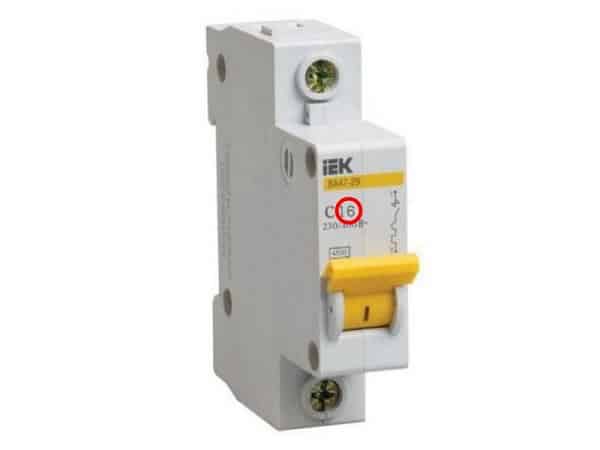
Thermal parameters
This term means the conditions for the operation of the thermocouple. These data can be obtained from the corresponding time-current graph.
Maximum breaking capacity (PSC).
This term indicates the maximum permissible load value at which the device will be able to open the circuit without losing performance. In Figure 5, this marking is indicated by a red oval.
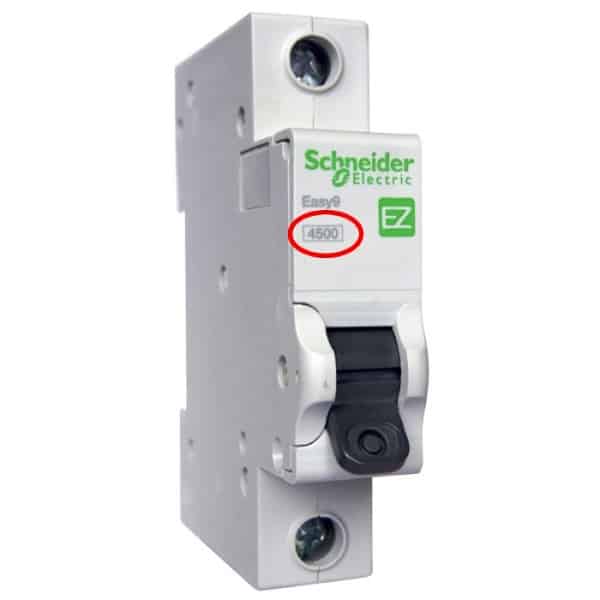
Fig. 5. The device of the company Schneider Electric
Current limit categories
This term is used to describe the ability of AB to disconnect the circuit before the fault current in it becomes maximum. The devices are manufactured with current limitation of three categories, depending on the time of load disconnection:
- 10 ms. and more;
- from 6 to 10 ms;
- 2.5-6 ms.
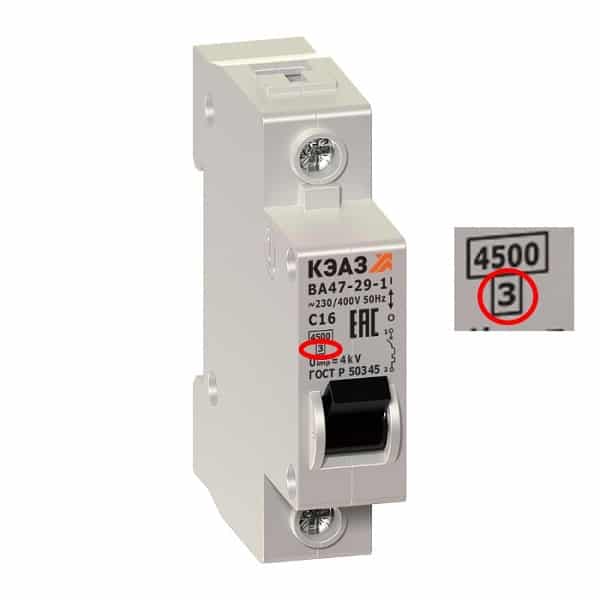
Note that ABs belonging to the first category may not have a corresponding marking.
A little lifhak about how to choose the necessary switch for home
